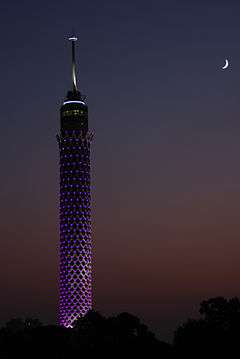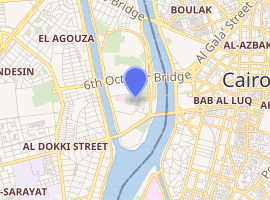Cairo Tower
The Cairo Tower (Egyptian Arabic: برج القاهرة, Borg El-Qāhira) - commonly known to locals as "Nasser's Pineapple" (Arabic: اناناسة ناصر Ananas Nasser)[2] - is a free-standing concrete tower in Cairo, Egypt. At 187 m (614 ft), it has been the tallest structure in Egypt and North Africa for about 50 years. It was the tallest structure in Africa for ten years until 1971, when it was surpassed by Hillbrow Tower in South Africa.
| Cairo Tower | |
|---|---|
Arabic: برج القاهرة Borg El-Qahira | |
 Cairo tower in 2008 | |

| |
| General information | |
| Type | Communications, observation, restaurants, visitor attraction |
| Architectural style | Ancient Egypt |
| Location | Cairo, Egypt |
| Coordinates | 30°02′45″N 31°13′28″E |
| Construction started | 1956 |
| Completed | 1961 |
| Opening | 1961[1] |
| Cost | $6m |
| Owner | Government of Egypt |
| Height | |
| Antenna spire | 187 metres (614 feet) |
| Roof | 159 m (521.7 ft) |
| Top floor | 142.6 m (467.8 ft) |
| Technical details | |
| Lifts/elevators | 3 |
| Design and construction | |
| Architect | Naoum Shebib |
| Website | |
| cairotower.net (requires Adobe Flash; in English) | |
One of Cairo's well-known modern monuments, sometimes considered Egypt's second most famous landmark after the Pyramids of Giza, it stands in the Gezira district on Gezira Island in the River Nile, close to downtown Cairo.
History
Built from 1954 to 1961, the tower was designed by the Egyptian architect Naoum Shebib, inspired by the Ancient Egyptian Architecture.[1] Its partially open lattice-work design is intended to evoke a pharaonic lotus plant, an iconic symbol of Ancient Egypt. The tower is crowned by a circular observation deck and a rotating restaurant[3] with a view over greater Cairo. One rotation takes approximately 70 minutes.
In the 1960s, Egyptian President Gamal Abdel Nasser announced that the funds for the construction of the Tower originated with the Government of the United States, which had provided $US6 million to him as a personal gift with the intent of currying his favour. Affronted by the attempt to bribe him, Nasser decided to publicly rebuke the U.S. government by transferring all of the funds to the Egyptian government for use in building the tower, which was 'visible from the US Embassy just across the Nile, as a taunting symbol of Egypt's, Africa and the Middle East's resistance, revolutions and pride'.[4]
Between 2006 and 2008 it underwent a EGP 15 million restoration project, completed in time for its fiftieth anniversary on April 2011.
Gallery
 Cairo Tower Entrance
Cairo Tower Entrance Cairo Tower from below
Cairo Tower from below.jpg) Cairo Tower
Cairo Tower Cairo Tower at sunset
Cairo Tower at sunset
See also
- List of tallest buildings in Cairo
- List of tallest buildings and structures in Egypt
- List of tallest structures in the Middle East
- List of tallest structures in the world by country
- List of tallest towers in the world
- List of revolving restaurants
References
- "TourEgypt: Cairo Tower".
- https://www.funtrivia.com/playquiz/quiz3889232c858b0.html
- http://www.lonelyplanet.com/egypt/cairo/sights/landmarks-monuments/cairo-tower
- Mousa, Sarah. "Commemorating the United Arab Republic". Al Jazeera. Retrieved 5 March 2017.
External links
| Wikimedia Commons has media related to Cairo Tower. |
- cairotower.net, tower's official website (requires Adobe Flash; in English)
- Cairo Television Tower at Structurae
- 'The Cairo Tower' by Samir Raafat
- http://www.ozy.com/flashback/egypts-giant-middle-finger-to-america/69659